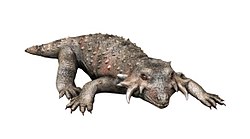| Hwiccewyrm Temporal range: Late Triassic, ~ | |
|---|---|
 | |
| Holotype skull as seen from multiple angles | |
| Scientific classification | |
| Domain: | Eukaryota |
| Kingdom: | Animalia |
| Phylum: | Chordata |
| Clade: | † Parareptilia |
| Order: | † Procolophonomorpha |
| Family: | † Procolophonidae |
| Subfamily: | † Leptopleuroninae |
| Genus: | † Hwiccewyrm Butler et al., 2023 |
| Type species | |
| †Hwiccewyrm trispiculum Butler et al., 2023 | |
Hwiccewyrm (meaning " Hwicce dragon") is an extinct genus of leptopleuronine procolophonid parareptile from the Late Triassic Magnesian Conglomerate of England. The type, and currently only, species is H. trispiculum. [1]


